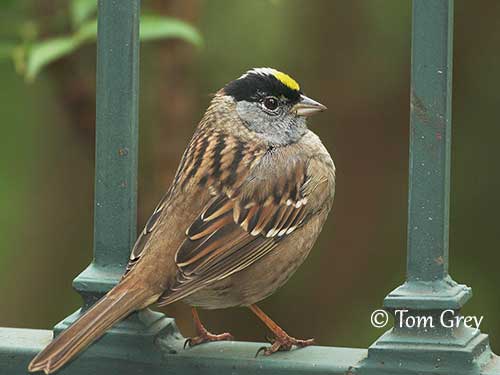
Fr: Bruant à couronne dorée
Ang: Golden-crowned Sparrow
All: Kronenammer
Esp: Chingolo Coronidorado
Ita: Passero capodorato
Nd: Goudkruingors
Sd: gulkronad sparv
Photographer:
Tom Grey
Tom Grey's Bird Pictures & Tom Grey's Bird Pictures 2
Text by Nicole Bouglouan
Sources:
HANDBOOK OF THE BIRDS OF THE WORLD Vol 16 by Josep del Hoyo- Andrew Elliot-David Christie – Lynx Edicions – ISBN: 9788496553781
FIELD GUIDE TO THE BIRDS OF NORTH AMERICA - National Geographic Society -ISBN: 0792274512
All About Birds (Cornell Lab of Ornithology)
Bird Web (Seattle Audubon Society)
What Bird-The ultimate Bird Guide (Mitchell Waite)
Wikipedia, the free encyclopaedia
Golden-crowned Sparrow
Zonotrichia atricapilla
Passeriformes Order – Passerellidae Family
INTRODUCTION:
The Golden-crowned Sparrow is a large sparrow of the W coast of North America. It is closely related to the White-crowned Sparrow, but recent DNA studies make it a separate species. It is a more distant relative of the White-throated Sparrow, but hybridization with both species is reported.
The Golden-crowned Sparrow is common along the W coast, from its breeding range in N to its wintering grounds in S (Baja California). It nests on the ground, well hidden in bush or dense clump of grass. It forages also on the ground and in low vegetation, where its cryptic plumage makes it almost invisible.
The Golden-crowned Sparrow is not globally threatened. It is common and widespread throughout its range.

DESCRIPTION OF THE BIRD:
Biometrics:
Length: 15-18 cm
Weight: 21-36,5 g
The Golden-crowned Sparrow adult has brownish back, mantle and scapulars with conspicuous darker streaks, whereas rump and uppertail-coverts are unstreaked and mostly brownish-grey. The fairly long tail is brown and slightly notched. On the upperwing, two white wingbars are formed by the pale tips of both median and greater coverts.
The underparts, including chin and throat, are grey with paler belly and buffy flanks.
On the head, the blackish-brown crown shows a conspicuous, broad, golden yellow median crown stripe. Lores and ear-coverts are grey, sometimes with indistinct streaking. Rest of head is grey like the underparts.
The two-tone bill has dusky upper mandible and flesh-coloured lower one. The eyes are deep brown. Legs and feet are pinkish-brown.
Male and female are similar, with male slightly larger than female.
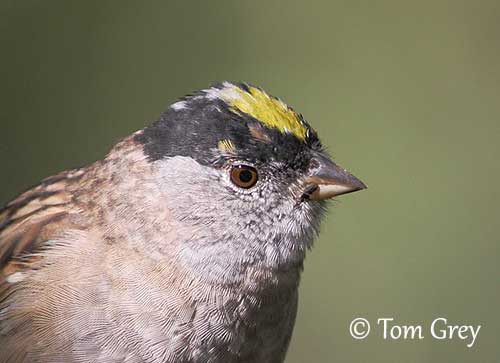
In non-breeding plumage, the adult has much duller head pattern with variable amount of black and yellow, depending on each individual. During winter, the crown is mostly brown with less conspicuous yellowish crown stripe.
The immature resembles adult in winter.
The juvenile has brownish crown, sometimes tinged with yellow and faintly streaked brown. Breast and body sides are streaked blackish-brown. The head pattern develops in second winter.
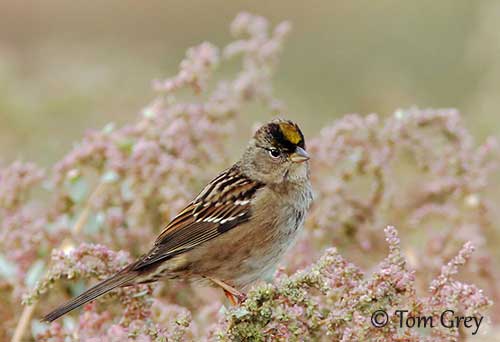
RANGE:
The Golden-crowned Sparrow breeds in Aleutian Islands and W and NC Alaska, W Canada and adjacent USA (extreme NW Washington). It winters from S Alaska and S British Columbia, S to SW USA (S to W California and E Nevada), and NW Mexico (N and C Baja California, rarely S to Sonora).
HABITAT:
The Golden-crowned Sparrow breeds in shrubby habitats and high mountains, up to 2700 metres of elevation. It is found in willow thickets at the edge of the dry tundra and stunted boreal bogs near the tree line.
It winters in a variety of brushy habitats and frequents wild chaparral, parks and gardens.
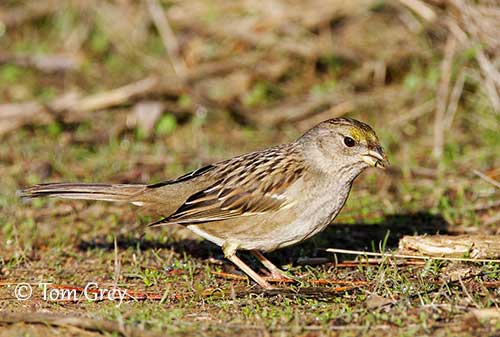
CALLS AND SONGS: SOUNDS BY XENO-CANTO
The Golden-crowned Sparrow’s calls include a loud “chink” and a high-pitched “tseet” in flight.
The song is a series of three (or more) descending, plaintive, whistled notes sounding like “oh dear me”. However, a series of five notes can be heard too “oh dear me-me-me” (information from the photographer Tom Grey - GALLERY ).
BEHAVIOUR IN THE WILD:
The Golden-crowned Sparrow feeds primarily on seeds and insects. During the breeding season, it probably takes more insects and spiders to feed the chicks. But during winter, it mainly consumes seeds of grasses and other plant material such as buds, flowers, shoots and berries.
The Golden-crowned Sparrow is mostly terrestrial and forages primarily on the ground and also in low vegetation, usually under or near dense thickets, or sometimes up in shrubs or low trees. It scratches soil and leaf litter while searching for food, and moves by hopping and walking.
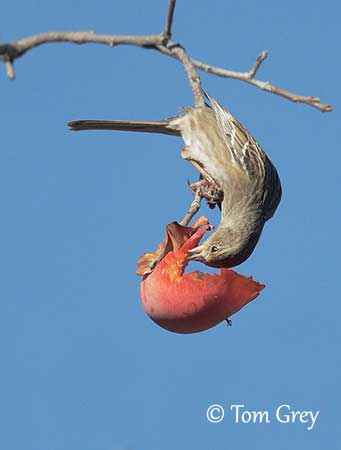
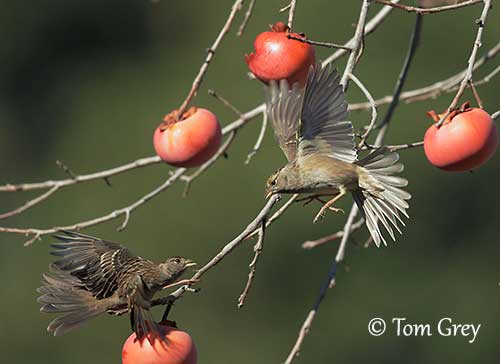
Aggressive encounter
on the feeding area
Outside the breeding season, it often forages in flocks. But during the nesting period, the male defends the territory by singing from exposed perch. The courtship displays are poorly known. The male may stay close to its mate during the egg laying, performing mate-guarding. The displays probably enhance the bright black and yellow head pattern by adapted movements and postures. They are monogamous, and pair formation occurs on arrival on the breeding grounds.
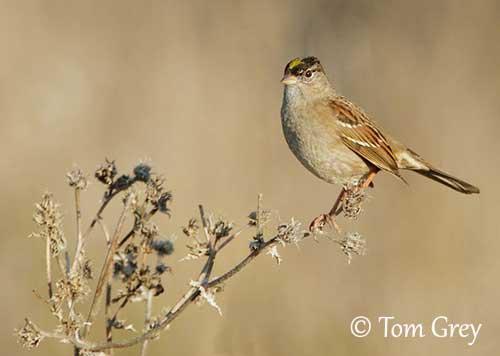
The Golden-crowned Sparrow is migratory and moves S after breeding, flying along the coastal slope. It usually leaves the breeding grounds from mid-August and reaches C California by mid-September. But large groups can be seen between late September and mid-October. They return N between early March and early April, and reach the breeding grounds from middle to late April into late May.
The Golden-crowned Sparrow performs short flights with rapid wingbeats.
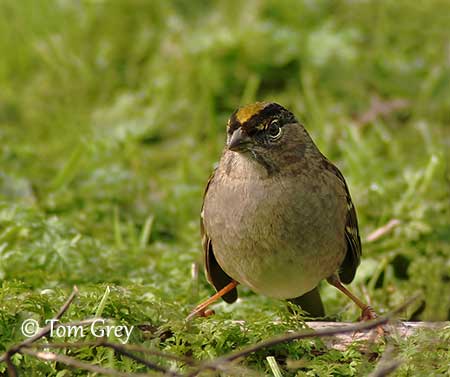
REPRODUCTION OF THIS SPECIES:
The breeding season occurs in June/July. This species usually produces a single brood, rarely two.
The female builds the nest, usually on the ground, hidden among and under the vegetation. She builds a thick cup with grasses, twigs, moss, leaves and ferns. It is lined with finer grass and some animal hair and bird feathers. The nest is sometimes placed near a stream.
She lays 4 creamy-white to pale greenish eggs with reddish-brown spots. She incubates alone during 11-12 days. She is fed by the male during this period. The chicks are fed by both parents. They leave the nest 9-10 days after hatching.
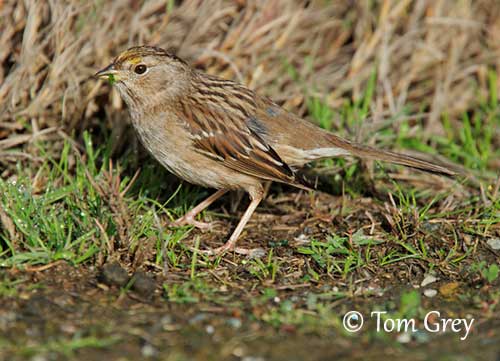
PROTECTION / THREATS / STATUS:
The Golden-crowned Sparrow is fairly common to locally common throughout its range. The size of the population is unknown, but an insignificant increase over the last decades is reported.
The Golden-crowned Sparrow is currently evaluated as Least Concern.
